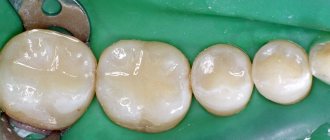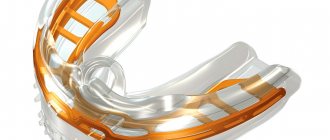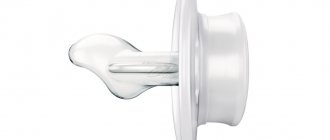The procedure of silvering teeth is the impregnation of areas affected by caries with silver, which strengthens dentin and enamel. In addition, silver disinfects the affected areas, eliminating cariogenic microorganisms, as a result of which the development of caries is suspended.
Most doctors prescribe silvering exclusively for children under 3 years of age who do not allow the dentist to cure the tooth. In most cases, the doctor manages to come to an agreement with older children, but much still depends on the dentist’s ability to find a common language with the little patient, calm him down and convince him that it won’t hurt. If the child is not afraid and fulfills the doctor’s requirements, then installing a filling will be a much more effective means in the fight against caries.
The development of caries in young children occurs much faster than in adults. First of all, carious formations affect the central incisors (mainly their front surface) and fourth teeth.
In children, caries, as a rule, is cervical, that is, covering the neck of the tooth with adjacent areas. A carious formation that appears in the first year of a baby’s life will develop to such an extent by the age of 2.5 that the crown of the tooth breaks off. Often caries is accompanied by the formation of fistulas and lumps, which indicates a purulent process occurring in the upper regions of the roots of the affected teeth.
Why is fluoridation necessary for children?
The body in childhood experiences fluoride deficiency. The main factors influencing this are:
- Genetic predisposition.
- General condition of the body. For example, some diseases increase the lack of fluoride, and teeth weaken.
- Poor nutrition.
- Lack of normal child development.
| Due to the factors listed above, tooth enamel weakens and they become sensitive to any changes. The child feels pain when drinking cold or hot drinks or food. Without fluoride, enamel is destroyed and teeth become vulnerable to disease. If caries begins to develop in childhood, there is a high probability that by the age of 30 a person will be missing at least several teeth. Deep fluoridation is an effective preventive measure that increases the resistance of teeth to negative external influences. The risk of disease is reduced many times over. Fluoridation is especially effective when combined with proper hygiene. The child should visit the dentist regularly, use safe brushes and toothpaste recommended by the doctor. |
Important information about the silver plating procedure
- If caries has managed to overcome the initial stage and is already affecting the dentin, then silvering in this case will be a useless measure. Dentin in children is softer than in adults, and caries develops at twice the rate. When caries has entered the middle stage, even with silvering once a month there is no absolute guarantee that the lesion will not develop into pulpitis. Remember that silver plating is not a panacea! The procedure makes it possible to hold out until the child reaches the age of 3 years in order to carry out full treatment.
- Applying silver to exposed dentin can cause burns to the pulp, which will lead to the development of pulpitis, as the chemicals will be able to easily penetrate the nerve of the tooth. The onset of pulpitis is indicated by severe pain that is difficult to relieve. The doctor performing silvering must accurately calculate the time of application of the solution so as not to damage the pulp.
- Teeth treated with silver change their color, especially if their surface is treated with Russian or Belarusian preparations. The teeth take on a black tint, which looks extremely unaesthetic. Japanese-made solutions also change the color of teeth, but not to black, but to light gray, which is not so noticeable.
Indications and contraindications
Deep fluoridation can be carried out from early childhood (from one and a half years). Contraindications
minimum:
|
|
Indications
There is much more to applying the method:
|
|
|
|
|
|
How does fissure sealing with sealants work?
The main indications for fissure sealing are the average and high risk of developing dental caries (i.e. in the case of more than 1 carious cavity per year). In children under 6 years of age, fissure sealing is carried out in primary molars, and in children over 6 years of age - in erupting permanent molars and premolars. Fissure sealing can be carried out immediately after the chewing surface of the tooth has erupted, without waiting for the entire tooth crown to erupt.
How fissure sealing protects against caries:
- Firstly , with the help of filling material, a barrier is created on the chewing surface of the tooth, which prevents the impact of various cariogenic factors on the fissures. Thus, sealing teeth with sealants prevents the retention of food debris in the depths of fissures, as well as the effects of organic acids produced by cariogenic bacteria.
- Secondly , sealing teeth can increase the resistance of tooth enamel to organic acids produced by cariogenic bacteria (if the material used for sealing fissures contains active fluoride ions). This promotes the mineralization of enamel deep in the fissures and additionally prevents the development of caries.
Important: the effectiveness of this method of caries prevention has been confirmed by numerous clinical studies. For example, professional fluoridation of teeth with varnish leads to a reduction in the increase in caries on treated surfaces by up to 70%. In turn, the fissure sealing method leads to a decrease in the increase in fissure caries over 1 year - already at the level of 92.5% (on average). And even higher efficiency can be achieved if these methods are combined.
How is the procedure done?
Deep fluoridation
It is carried out only in a dental office using special preparations.
The procedure requires minimal preparation. It can be divided into five quick stages
:
- Teeth cleaning. Usually a special paste is used to prepare for fluoridation. But if the child has heavy plaque, another cleaning method is chosen.
- Drying the surface of the teeth.
- “Sealing” the enamel. The doctor applies a drug based on magnesium and calcium (fluorides).
- Second drying of the surface of the teeth.
- Application of the final preparation. Dental clinics use a solution of copper and calcium hydroxide.
| After the procedure, both applied layers react. All components gradually penetrate deep into the tooth, significantly enhancing its mineral structure. An important advantage of deep fluoridation is durability. Components applied to the surface are not washed out and are not affected by food or water. |
Alternatives to Remineralizing and Whitening Teeth Varnishes
Various gels, foams and toothpastes are actively used in dentistry to remineralize teeth. Moreover, remineralizing gels and pastes can be used at home. For example, ASEPTA PLUS Remineralization toothpaste with hydroxyapatite, plant extracts, papain and thermal mud helps strengthen teeth and gums and reduces sensitivity. This paste should be used as usual: twice a day for 3 minutes.
Gels for remineralization at home are used in courses. The gel is applied with a toothbrush or finger to all surfaces of the teeth, cleaned of plaque, and left for the time specified in the instructions. Such products can be used in conjunction with universal mouth guards. Remineralizing gels are safe if accidentally swallowed. Their use is indicated after professional cleaning procedures.
For whitening, you can choose a special toothpaste. The effect of its use is cumulative and long-lasting, unlike whitening varnishes for home use, but less pronounced. Professional whitening pastes allow you to lighten the enamel by several tones. Particularly noticeable results are achieved in conjunction with professional teeth cleaning. For effective and safe enamel whitening, we recommend ASEPTA Gentle Whitening toothpaste. The fluoride-free paste contains fine abrasive components that clean the enamel of plaque without leaving microcracks. ASEPTA toothpaste prevents the occurrence of caries and sensitivity.
Interesting products for teeth whitening at home - strips, foam, gel stick. Sticky whitening strips absorb and break down dark pigments and plaque from the surface of teeth, resulting in a lighter natural shade of teeth. You will get visible results within 7 days of regular use of the strips, the maximum effect is achieved within 14 days.
Additional oral care in the form of whitening foam is intended for hygiene throughout the day. Recommended use after every meal. Thick foam breaks down soft plaque even in the most difficult to reach areas, without the need for a toothbrush or water. The active components of the product act on the surface of the enamel and penetrate into its deeper layers, discoloring coloring pigments. Additionally, the product helps strengthen tooth enamel and reduce sensitivity. This is the best option for those who wear braces or other orthodontic structures.
A whitening gel pencil can lighten teeth by 2-4 shades within a week of use. The use of individual trays improves the result, since the gel must be kept on the teeth for 5–7 minutes.
Advantages of fluoridation compared to silver plating
Previously, silver plating was used as a preventative measure. But most leading dental clinics abandoned it in favor of deep fluoridation. Here are the reasons:
|
Dentists speak flatteringly about the deep fluoridation procedure. In an interview with the newspaper “Arguments and Facts”, maxillofacial surgeon David Grigoryan Fr.
You can carry out deep fluoridation at our Nikadent clinic in Mytishchi. The cost of the service is quite affordable - about 2.5 thousand rubles. This price includes: professional consultation, preparation, cleaning of tartar, drying of teeth, application of fluoride.
Fissure sealing in children: price 2022
For fissure sealing in children, the price will range from 600 to 1,200 rubles per tooth (in economy-class and mid-price clinics). This difference in cost will depend on the sealing method - invasive or non-invasive, as well as on the type of material for sealing the fissures.
The method of non-invasive sealing of fissures (without opening them with a drill) is always cheaper. But if you have narrow, deep fissures that will need to be opened with a drill before inserting the material, the price will be around 1,200 rubles without the cost of anesthesia. You will have to pay another 300-400 rubles for pain relief.
Prices for pediatric dentistry
| Child therapy | |
| Children's professional oral hygiene | 2,200 rub. |
| Filling teeth with glass ionomer cement (Fuji, Vitremer) | 1,500 rub. |
| Dental treatment using vital amputation in one visit (excluding anesthesia) | 3,600 rub. |
| Seal “Dyract” | 2,200 rub. |
| Pulp amputation with placement of a therapeutic bandage | 1,200 rub. |
| Mechanical and medicinal treatment of carious cavity | 500 rub. |
| Application of devitalizing paste | 500 rub. |
| Deep fluoridation of all teeth | 2,500 rub. |
| Carrying out the resorcinol-formalin method (one session) | 700 rub. |
| Filling root canals with paste (one canal) | 300 rub. |
| Carrying out the method of silvering baby teeth (one tooth) | 200 rub. |
| Application of medicinal paste “Pulpotek” | 1,000 rub. |
| Temporary chemical filling | 300 rub. |
Indications for fluoridation
Pediatric dentists recommend remineralization therapy in the following situations:
- prevention of caries;
- with increased sensitivity of tooth enamel;
- during teething;
- caries was detected in the white spot stage;
- restore enamel and reduce its sensitivity before installing or after removing the bracket system;
- normalization of the microflora of the oral cavity.
What is the procedure
Fluoridation in children is carried out to protect children from caries, since they have a very fragile bone structure. For this reason, caries in children progresses very quickly, destroying the incisors. The procedure is aimed at strengthening the enamel by applying microscopic crystals with fluoride particles to it.
It reliably seals the dentinal canals, increasing the thickness and strength of the enamel. This treatment allows baby teeth to be more resistant to various mechanical damage, pathogenic microorganisms and food acids. The procedure allows you to quickly restore the mineral composition of the enamel.
Quite often, parents neglect the condition of baby teeth and the child. And this subsequently leads to problems and diseases at an older age. Therefore, at the slightest sign of caries or if the integrity of the enamel is damaged, it is necessary to visit the dentist. Only a doctor decides whether children need fluoridation.
There are 2 types of procedure:
- Simple fluoridation, in which strengthening enamel, gel or varnish is applied to the surface. These components cannot protect the MH from caries, so this procedure is in most cases carried out for preventive purposes.
- Deep fluoridation of teeth in children is carried out using special enamel, after application of which the liquid firmly seals microcracks, penetrating into the very depths of hard tissue. It contains a large amount of fluoride ions, which not only strengthen the enamel, but also protect teeth even from deep lesions. The enamel becomes dense, due to which children do not experience subsequent destruction of baby teeth. After this procedure, children are not diagnosed with caries, and temporary teeth remain healthy until permanent teeth appear.
Positive effect of fluoridation
- The procedure enhances the protection of milk and permanent teeth from caries.
- By strengthening the enamel and improving its density, MGs are not subject to destruction and are resistant to mechanical stress.
- The procedure is painless and the baby does not experience discomfort.
- After applying the composition, the incisors remain snow-white and do not darken.
- Sensitivity to cold, hot, sweet foods decreases.
- If fillings are treated with the substance, their service life increases.
- For prevention, the procedure is carried out 1-2 times a year.
Purpose and usefulness of fluoridation
The goal of fluoridation is to restore a healthy balance of minerals in the tissues of baby teeth. Thanks to the saturation of the microelement, the enamel of children's teeth becomes more resistant to the action of pathogens and acquires a certain immunity to the influence of acidic environments.
The fluoridation procedure allows you to stop tooth decay, as well as prevent the spread of carious lesions to healthy teeth. Caries is a disease whose danger cannot be ignored: it can cause premature loss of baby teeth, which in turn can lead to the development of malocclusion. After saturating the enamel with fluoride, its excessive sensitivity also decreases.
At what age is fluoridation allowed?
Remineralization of teeth is allowed from the age of two. The first procedure can be performed immediately after the first baby teeth have erupted. The second critical period for tooth enamel is adolescence. During this period, hormonal changes occur in the body, affecting the functioning of all organs and systems.
There is a change in the composition of saliva, and newly formed permanent teeth have insufficiently strong enamel, that is, it is not able to properly withstand the aggressive onslaught of pathogenic microorganisms. Therefore, during adolescence, dental fluoridation is a completely justified preventive procedure.











